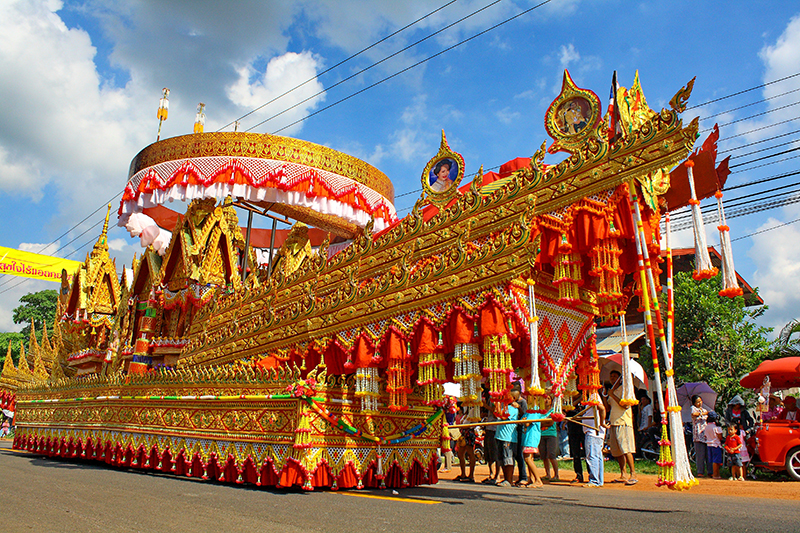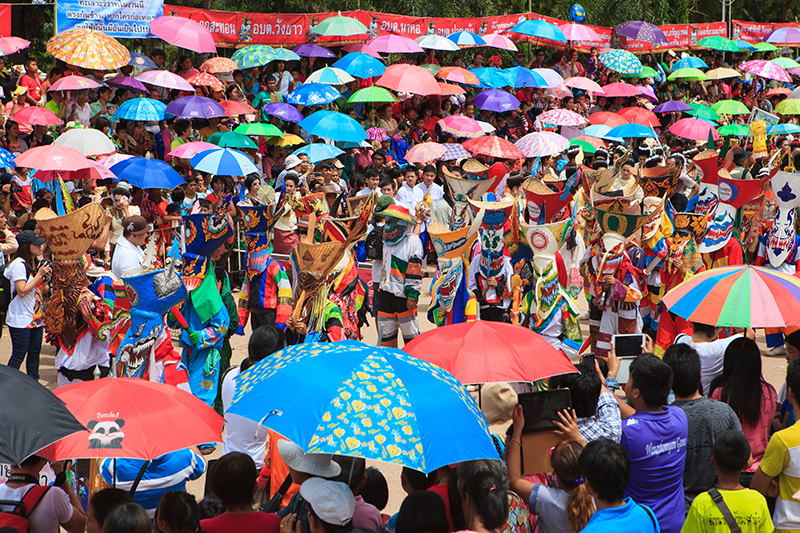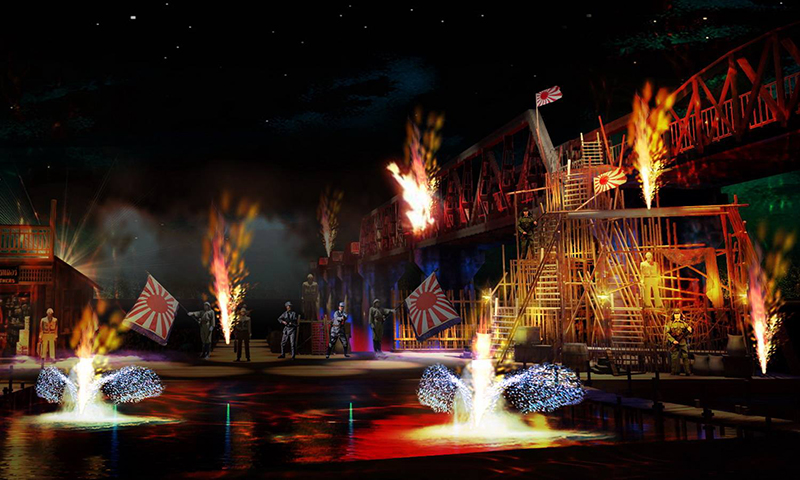Thailand is a land of festivals and celebrations that reflect Thai traditions and cultural values. Most Thai festivals derive from the Buddhist and Brahman beliefs, with many being originated from local traditions, folklore and the way of life. Many have taken place over the course of a year for centuries.
Two internationally known festivals are Songkran or the Thai New Year with its water-based fun and the charming full moon festival of Loi Krathong. And among many religious events tourists are encouraged to witness include the ‘Khao Phansa’ and ‘Ok Phansa’ festivals that respectively mark the beginning and the end of Buddhist Lent.
Each Thai festival has its own outstanding features, which differ from region to region, and here are just some of the many events and festivals celebrated annually in Thailand.
World Wai Kru Muay Thai Ceremony
17 March, Ayutthaya
The annual World Wai Kru Muay Thai Ceremony, held annually at the Ayutthaya Historical Park, allows the opportunity for hundreds of Muay Thai practitioners from around the world to express their gratitude to their masters in the time-honoured tradition known as the Wai Kru ceremony, as well as to celebrate the aged-old martial art of Muay Thai.
The event begins with an afternoon Muay Thai fair featuring unique Thai traditions including sword-making, Thai tattooing and calligraphy and Thai martial art shows. Taking place thereafter is the highlight: the ceremony to pay respect to ancient Thai kings and warriors who protected the sovereignty of the land; namely, King Naresuan the Great, Phrachao Suea, and Phraya Phichai Dap Hak, with a Wai Kru dance performed by all participating Muay Thai boxers.

Poi Sang Long Festival
March-April, Mae Hong Son
The annual Poi Sang Long Festival is an aged-old ordination ceremony undergone by boys between seven and 14 years of age of the Tai Yai ethic group in Northern Thailand, but mostly synonymous with Mae Hong Son province. Usually, a large group of boys are ordained as novice monks at the same time. The three-day ritual is believed to help gain more merit than an ordinary ordination.
On the first day, the boys enter a tonsure ceremony and dress up in the Sang Long dress. On the second day, the boys are carried on the shoulders of their male relatives or mentors, as their feet are not allowed to touch the ground except at home and in the temple. On the last day, the novice monks enter the temple for a period, which can vary from a week to many months or more.

Songkran Festival
13-15 April, nationwide
Songkran Festival is an event where boisterous fun and ancient traditions go hand-in-hand. For tourists, the event offers a chance to enjoy a huge celebration where water parties break out in the streets of Thailand’s towns and villages. For locals, it is a time when they can spend precious moments with their families and visit the temples to observe ancient rites and make merit.
Some of the best locations to celebrate the Songkran Festival, region-by-region, are: Central and Eastern Region: Bangkok and Pattaya; Northern Region: Chiang Mai; Northeastern Region: Khon Kaen; and Southern Region: Hat Yai.

Bun Bung Fai (Rocket) Festival
May or June, some provinces in the Northeast and South
Among the most spectacular festivals to be experienced in the Thailand is the annual rocket festival, which takes place in the Northeast as the rainy season begins. Known as Bun Bung Fai, the festival is seen as a way of encouraging the rains to fall and to help the local rice crops to grow. It also allows people to have a fun and festive break before the hard work of planting and harvesting begins.
The celebrations differ from province to province, but mostly involve the firing of homemade rockets up into the sky with teams competing against each other to send their rockets the highest. There are also parades with floats and displays of traditional costume and dancing.
The Festival can be enjoyed in many provinces of Isan including Roi Et, Yasothon and Kalasin. There is also a rocket festival in Sukhirin district in the southern province of Narathiwat, initiated by people who moved south from Isan.

Bun Luang and Phi Ta Khon Festival
June-July, Loei
One of the most vibrant, and distinctly unique festivals in Thailand’s Northeastern Region is the Bun Luang and Phi Ta Khon Festival in Dan Sai district, Loei. The three-day event normally takes place during the first week after the sixth full moon of the year (in June or July).
The entire event is traditionally called Bun Luang, a mass merit-making ceremony organised with the aim to celebrate the return of Prince Vessandorn (the last incarnation of Lord Buddha) and to worship Phra That Si Song Rak, the highly-revered Buddha stupa for both Thai and Lao people.
But the highlight is the Phi Ta Khon masked-dance procession. Villagers, mostly male, dress in ghost costumes and wear huge masks made from carved coconut-tree trunks, topped with wickerwork and sticky rice steamers, dance and strike amusing poses to the cheerful crowds as they parade around town. Other activities include Phi Ta Khon costume competition and the firing of Bung Fai (rocket).

Khao Phansa or Buddhist Lent Day
On the day after the full moon of the eighth lunar month (normally in July), nationwide
One of the most charming festivals celebrated in Thailand is Khao Phansa, or Buddhist Lent Day, which marks the start of the rainy season and the period when monks traditionally retreat to their temples for a three-month period. Traditionally, candles were donated to temples enabling monks to continue their studies into the evenings. Nowadays, these offerings take the form of huge wax effigies, which are shown off in local parades accompanied by folk dances, displays of local crafts, and sound and light performances.
Khao Phansa day itself is a day of special celebration and is held on the day after the full moon of the eighth lunar month (normally in July). But many of the celebrations to mark the festival will take place over several days during the week. Some of the best locations to witness spectacular candle parades are Ubon Ratchathani, Saraburi (Tak Bat Dok Mai or flower offering), Ayutthaya and Nakhon Phanom.

OK Phansa or End of Buddhist Lent Day
On the full moon of the 11th lunar month (normally in October), nationwide
The Ok Phansa festival is celebrated on the full moon of the 11th lunar month and marks the end of the Buddhist Lent. It is a time of celebration and merit-making with provinces nationwide set to celebrate the occasion on different days and in distinctive styles, depending on their locality and tradition.
Among the notable Ok Phansa celebrations include Nakhon Phanom Illuminated Boat Procession, Sakon Nakhon Wax Castle Festival, Naga Fireball Festivals in Nong Khai and Bueng Kan, Chaiyaphum ‘Ti Khli (fireball croquet)’ competition, Samut Prakan Rap Bua (receiving lotus) Festival, Uthai Thani ‘Tak Bat Devo’ Ceremony, and Mae Hong Son ‘Chong Phara’ procession of the Tai Yai ethnic group.
In the Southern region, several provinces including Surat Thani, Phatthalung and Trang are famous for their unique Chak Phra, Lark Phra or Hae Phra ceremony, where a highly-revered Buddha image is carried on beautifully decorated floats and hauled in the river or on the road, allowing Buddhist devotees to join in making merit.

Long-boat Racing Festivals
Normally held coinciding with the Ok Phansa Festival at selected locations nationwide
There are many long-boat racing festivals organised in Thai provinces where big rivers pass; such as, Phichit, Phitsanulok, Ayutthaya, Ang Thong, Saraburi, Pathum Thani, Nan and Surat Thani.
The Phichit Traditional Long-boat Races is the first type of such festival held in Thailand as well as one of the oldest. It is also regarded as one of the grandest and most spectacular boat races in the country. Meanwhile, the Nan Boat Races, initially organised to mark the end of the Buddhist Lent, has become a fixture on Thailand’s annual festival calendar, having the most numbers of boats entering the races or about 200 boats from over 100 communities. In the South, the annual Surat Thani Long-boat Races is held alongside the Chak Phra Festival.

Vegetarian Festival
Normally held for nine days during the period of the ninth lunar month (around October), nationwide
One of Thailand’s most unique and lively events, the Vegetarian Festival has its origins in Chinese culture. It is believed that abstinence from meat and stimulants will bring about good health and peace of mind to individuals and the community. Thus, a lot of Thai people, especially those of Chinese lineage, will restrict themselves to only a vegetarian diet for nine days and nine nights as a form of purification of a person’s body, mind and spirit.
Phuket boasts Thailand’s most famous Vegetarian Festival celebration, also known as the Nine Emperor Gods Festival, with notable ceremonies including the processions of god images and of celebrants in a trance-like state displaying awe-inspiring supernatural power. Other locations with unique celebrations have included Krabi, Trang, Phang Nga, Hat Yai, Surat Thani, Chumphon, Nakhon Ratchasima, Nakhon Sawan, Chon Buri (Pattaya) and Samut Sakhon.

Loi Krathong Festival
On the full moon night of the 12th lunar month (normally in November), nationwide
Nearly all visitors to Thailand agree that in this land of festivals, it is Loi Krathong that stands out as the most charming.
The annual ceremony is a time of special celebration in Thailand. The rains have mostly ended, and the weather is cool, so people take the chance to get out for the evening, socialise and enjoy many fun activities as well as making and floating krathongs. These are candlelit floats, traditionally made from banana stalk and leaf or coconut shell and decorated with incense, offerings, flowers and candles. They are then floated out onto the water as a way of paying respect to the water spirits to thank them for their bounty as well as to apologise to rivers and streams for pollution and for their use of water over the year.
Some of the best locations to see Thai people at their most fun loving while enjoying a genuinely beautiful spectacle include Bangkok, Samut Songkhram (Loi Krathong Kap Kluai), Tak (Loi Krathong Sai), Sukhothai (Candle Festival), Chiang Mai (Yi Peng Festival) and Roi Et (Somma Nam Khuen Pheng Seng Prathip).

River Kwai Bridge Week
November-December, Kanchanaburi
The River Kwai Bridge is one Thailand’s more recent historical attractions. It commemorates the sacrifice of British, American, Australian, Dutch, and New Zealand prisoners of war, in addition to the many Thai, Burmese, Chinese, Vietnamese, Malays, and Indians, who were part of the estimated 61,700 people who died there.
The River Kwai Bridge Week pays respect to their memory while also balancing the freedom all who attend enjoy. It is known for staging one of Thailand’s most spectacular sound and light shows that tells the stories of the World War II in honour of the prisoners of war who built the infamous Death Railway, the Bridge on the River Kwai and Hellfire Pass. The event normally takes place for 10 days around November and December.

For more information on other events and festivals in Thailand, call the TAT Contact Centre on 1672 or log on to www.tourismthailand.org.





